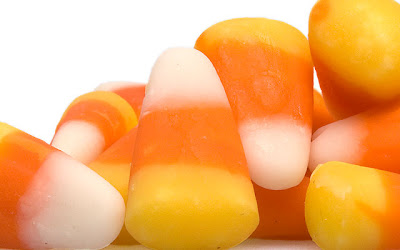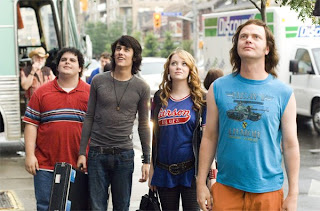Candy Corn by Ericka Scott
Out of all the seasons of the year, I love autumn the best. Cool temperatures in the evenings, falling leaves, scent of smoke in the air from fireplaces, and zombies, giant pumpkins, and a few skeletons stalking the neighborhood just sums up a few of my favorite things. But topping that list is (cue introductory music)
Candy Corn!

So, what does something so sweet and indulgent (pardon me while I have a handful) have to do with writing?
Layers.
When I first started writing, I wrote "the story" and when I was done, I submitted it. Needless to say, the rejections piled up. My premises were clever, plots were hole free, my grammar was impeccable, my prose polished -- so why were my stories not up to snuff?
I'm not one of those writers who thinks the problem lies with the editors, so I started thinking. (and then I thought some more). One day, while looking at a piece of candy corn, I had a eureka moment of sorts.
Candy corn tastes homogenous to me -- in fact, ChaCha assures me that all of the layers are flavored the same (except the ones with a brown bottom, where the brown is chocolate -- yum). Yet the layers are there for a reason -- perhaps for esthetics only -- but that's what makes the candy "corn." Which got me to thinking about layering in manuscripts.
The first layer is the plot (or the characters)
The second layer is the characters (or the plot)
Then, there's that white tip. It's tiny but vitally important for the overall presentation. That last and final layer is what brings the reader into the story and evokes a visceral response. The senses. Hearing, Sight, Touch, Smell and Taste.
Authors are often very good at telling their audience what things look and sound like, the other three elements often get neglected or relegated to a few central scenes. Textures, tastes, and scents all play a part in how we perceive our world. I equate them to putting the show in the telling of the story.
Use the scent to put your readers teeth on edge, use taste to make them drool, use textures to evoke familiarity -- If your story evokes those same responses in your audience in every scenes, you are one step closer to making your imaginary world very, very real to your reader.
So, the next time you grab a handful of candy corn, think about how you can bring all those layers into your manuscript.
Oh, and above all -- Enjoy!
Ericka Scott
Candy Corn!

So, what does something so sweet and indulgent (pardon me while I have a handful) have to do with writing?
Layers.
When I first started writing, I wrote "the story" and when I was done, I submitted it. Needless to say, the rejections piled up. My premises were clever, plots were hole free, my grammar was impeccable, my prose polished -- so why were my stories not up to snuff?
I'm not one of those writers who thinks the problem lies with the editors, so I started thinking. (and then I thought some more). One day, while looking at a piece of candy corn, I had a eureka moment of sorts.
Candy corn tastes homogenous to me -- in fact, ChaCha assures me that all of the layers are flavored the same (except the ones with a brown bottom, where the brown is chocolate -- yum). Yet the layers are there for a reason -- perhaps for esthetics only -- but that's what makes the candy "corn." Which got me to thinking about layering in manuscripts.
The first layer is the plot (or the characters)
The second layer is the characters (or the plot)
Then, there's that white tip. It's tiny but vitally important for the overall presentation. That last and final layer is what brings the reader into the story and evokes a visceral response. The senses. Hearing, Sight, Touch, Smell and Taste.
Authors are often very good at telling their audience what things look and sound like, the other three elements often get neglected or relegated to a few central scenes. Textures, tastes, and scents all play a part in how we perceive our world. I equate them to putting the show in the telling of the story.
Use the scent to put your readers teeth on edge, use taste to make them drool, use textures to evoke familiarity -- If your story evokes those same responses in your audience in every scenes, you are one step closer to making your imaginary world very, very real to your reader.
So, the next time you grab a handful of candy corn, think about how you can bring all those layers into your manuscript.
Oh, and above all -- Enjoy!
Ericka Scott

Comments
Post a Comment
We would love to hear from you but hope you are a real person and not a spammer. :)